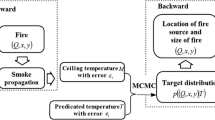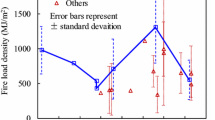Abstract
A probabilistic model for estimating the activation time of ceiling-mounted fire detection devices is described. The probabilistic model builds on the deterministic model, DETACT, by introducing probability distribution functions in place of point estimates for the parameters governing fire detector response, including the fire heat release rate history, the detector activation temperature, response time index and conductance parameter and the location of the device. The probabilistic model incorporates only parameter uncertainty. Model uncertainties associated with the deterministic model for estimating the activation time of ceiling mounted fire detectors have not been addressed. An example application of the probabilistic model is discussed. The probabilistic results provide valuable insights about the relevant parameters involved in a time to detection analysis.
Similar content being viewed by others
References
R.L. Alpert, “Calculation of Response Time of Ceiling-Mounted Fire Detectors,” Fire Technology, vol. 8, no. 3, 1972, pp. 181–195.
R.L. Alpert and E.J. Ward, “Evaluation of Unsprinklered Fire Hazards,” Fire Safety Journal, vol. 7, no. 2, 1984, pp. 127–143.
W.D. Davis, “Comments on ‘Correction Factors for the Heat of Combustion in NFPA 72 Appendix B,” Fire Protection Engineering, no. 4, 1999, pp. 46–48.
M.M. Delichatsios, “The Flow of Fire Gases Under a Beamed Ceiling,” Combustion and Flame, vol. 43, 1981, pp. 1–10.
Evans, “Ceiling Jet Flows,” SFPE Handbook of Fire Protection Engineering, 2nd edition, Quincy, MA: National Fire Protection Association, 1995.
D.D. Evans and D.W. Stroup, “Methods to Calculate Response Time of Heat and Smoke Detectors Installed Below Large Unobstructed Ceilings,” Fire Technology, vol. 22, no. 1, 1985, pp. 54–65.
J.D. Faires and R. Burden, Numerical Methods, 2nd edition, Pacific Grove, CA: Brooks/Cole Publishing Company, 1998.
R.P. Fleming, Theory of Automatic Sprinkler Performance, Section 6/Chapter 8, Fire Protection Handbook, 18th edition, National Fire Protection Association, Quincy, MA, 1997.
J. Friedman, “An Experimental Investigation of Heat and Smoke Detector Response,” MS Thesis, Department of Fire Protection Engineering, University of Maryland, 1998.
G. Heskestad, Fire Plumes, SFPE Handbook of Fire Protection Engineering, 2nd edition, Quincy, MA: National Fire Protection Association, 1995.
G. Heskestad and R.G. Bill, “Quantification of Thermal Responsiveness of Automatic Sprinklers Including Conduction Effects,” Fire Safety Journal, vol. 14, nos. 1/2, 1988, pp. 113–125.
G. Heskestad and R.G. Bill, “Modeling of Thermal Responsiveness of Automatic Sprinklers,” Fire Safety Science—in Proceedings of the Second International Symposium, 603–612, 1991.
G. Heskestad and M.A. Delichatsios, “The Initial Convective Flow in Fire,” in: Seventeenth Symposium (International) on Combustion, The Combustion Institute, Pittsburgh, pp. 1113–1123, 1979.
G. Heskestad and M.A. Delichatsios, “Update: The Initial Convective Flow in Fire. Short Communication,” Fire Safety Journal, vol. 15, no. 6, 1989, pp. 471–475.
G. Heskestad and H.F. Smith, “Investigation of a New Sprinkler Sensitivity Approval Test: The Plunge Test,” Technical Report Serial No. 22485. RC 76-T-50, Factory Mutual Research Corporation, Norwood, MA, 1976.
F. Kreith, Principles of Heat Transfer, 3rd ed., International Textbook Co., 1973.
C.E. Marrion, “Correction Factors for the Heat of Combustion in NFPA 72 Appendix B,” Fire Protection Engineering, No. 1, 35–36,38,40, 1998.
B.J. McCaffrey, “Momentum Implications for Buoyant Diffusion Flames,” Combustion and Flame, vol. 52, no. 2, 1983, pp. 149–167.
K. McGrattan, H.R. Baum, R.G. Rehm, A. Hamins, and G.P. Forney, Fire Dynamics Simulator—in Technical Reference Guide,” NISTIR 6467, National Institute of Standards and Technology, Gaithersburg, MD, January 2000.
F.W. Mowrer, “Lag Times Associated with Fire Detection and Suppression,” Fire Technology, vol. 26, no. 3, 1990, pp. 244–265.
F.W. Mowrer, “Methods of Quantitative Fire Hazard Analysis,” EPRI TR-100443, Electric Power Research Institute, Palo Alto, CA, 1992.
F.W. Mowrer, “Spreadsheet Templates for Fire Dynamics Calculations,” Report FP93-01, Department of Fire Protection Engineering, University of Maryland, 1993.
F.W. Mowrer and R.B. Williamson, Methods to Characterize Heat Release Rate Data, Fire Safety Journal, vol. 16, no. 5, 1990, pp. 367–387.
National Fire Alarm Code, NFPA 72-1999, National Fire Protection Association, Quincy, MA, 1999.
A. Papoulis, Probability, Random Variables, and Stochastic Processes, 3rd edition, p. 93.
Requirements and Test Methods for Sprinklers, ISO 6182-1.
SFPE Engineering Guide—The Evaluation of the Computer Model DETACT-QS, December 2002.
“Single and Multiple Station Smoke Alarms,” UL 217, Underwriters Laboratories, 1997.
Standard on Automatic Fire Detectors,” NFPA 72E-1984, National Fire Protection Association, Quincy, MA, 1984.
International Standards Organization, 1993.
Standard for Safety for Automatic Sprinklers for Fire-Protection Service, UL 199, Underwriters Laboratories, Inc., Northbrook, IL, 1999.
C.R. Theobald, “FRS Ramp Test for the Thermal Sensitivity of Sprinklers,” Journal of Fire Protection Engineering, vol. 1, no. 1, 1989, pp. 23–34.
R.L. Vettori, “Effect of an Obstructed Ceiling on the Activation Time of a Residential Sprinkler,” NISTIR 6253, National Institute of Standards and Technology, Gaithersburg, MD, November 1998.
Author information
Authors and Affiliations
Corresponding author
Rights and permissions
About this article
Cite this article
Joglar, F., Mowrer, F. & Modarres, M. A Probabilistic Model for Fire Detection with Applications. Fire Technol 41, 151–172 (2005). https://doi.org/10.1007/s10694-005-1268-7
Issue Date:
DOI: https://doi.org/10.1007/s10694-005-1268-7




